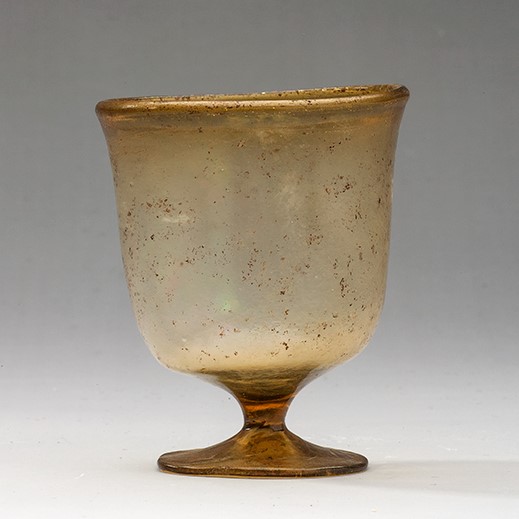Title: Short-Stemmed Goblet - 2001.01
Acquisition number: 2001.01
Author or editor: J.R. Green
Culture or period: Roman Imperial
Date: 4th - 7th century AD.
Material: Glass
Object type: Vessels - Cup/mug
Dimensions: 93mm (h)
Origin region or location: Egypt
Display case or on loan: 9
Keywords: Roman, Imperial, Egyptian, Glass
Charles Ede Ltd., Ancient Glass (2001) no. 31 (ill.)
2001.01
Short-Stemmed Goblet
Purchased. Ht 9.3cm. Presented by the Friends of the Classics Museum.
Intact though with some surface wear. Transparent pale yellowish green. Rim rolled in on deep bowl, carinated to flat base on short hollow stem, pulled out and folded to form foot, plugged at base.
Possibly Egyptian by fabric. The type seems to have originated in the Eastern Mediterranean but then spread widely in the West also. The colour is typical of the shape. Although goblets underwent a revival in glass in the fourth century, this particular form continued to be produced well into the early seventh century AD, with examples appearing in the sixth – early seventh across the Levant (D. Barag, Glass Vessels of the Roman and Byzantine Periods in Palestine [Ph.D. Diss. The Hebrew University, Jerusalem 1970], [in Hebrew], pl.33); it first appears at Pella in Jordan in early seventh-century earthquake debris (P. Watson in A. Walmsley, et al., “The Eleventh and Twelfth Seasons of Excavations at Pella (Tabaqat Fahl)”, Annual of the Department of Antiquities of Jordan 37, 1993, 204; M. O’Hea in K. da Costa, et al., “New Light on Late Antique Pella: Sydney University Excavations in Area XXXV, 1997”, Annual of the Department of Antiquities of Jordan 46, 2002, 503-533: fig 13).
Charles Ede Ltd., Ancient Glass (2001) no. 31 (ill.)
